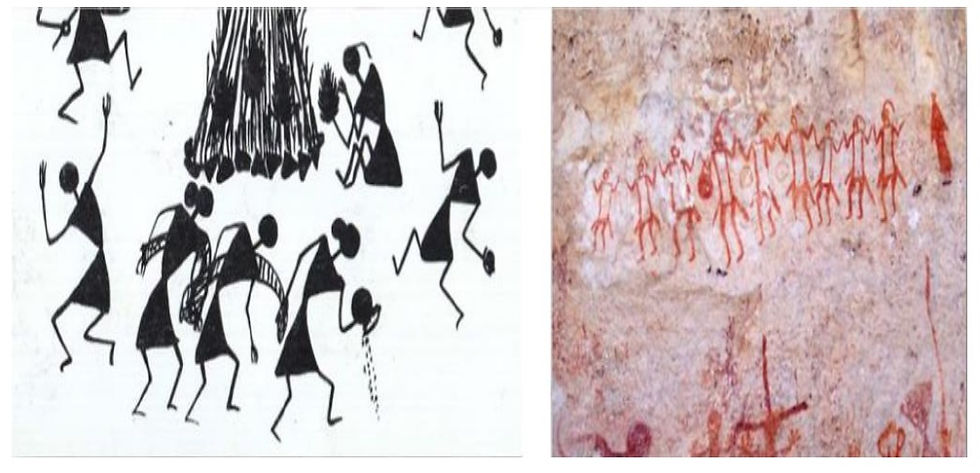In our previous blogs we discussed origin, development, techniques and many other aspects of Warli Painting. Today’s topic is a bit different. It is well-known and well accepted that compared to the other art forms practiced in other parts of India, Warli gains more popularity for his exotic nature and vibrant outlook. It gets appreciation from the viewer for the simplicity of its theme. We can notice the use of many vibrant dark colors in other folk art practiced in India whereas in Warli we can observe only two colors. But using fewer colors neither make it less vibrant nor make it less attractive than the other practiced art form.
The tribal values the sense of uniformity and the close social interactions with nature and the spirits is what makes the tribal who they are. For the tribal, life is an eternal circle. Death is not the end as much as it is a new beginning. Hence circles best represent the art of Tribal, which has neither an end nor a beginning. Warli Paintings are very much an ancient Indian folk art. Indian paintings have always been in the forefront for their superior creative and imaginative skills. Historians believe that the warli tradition traces back to as far as the Neolithic period from 2,500 BC to 3,000 BC. The purpose of these drawings remain ritual as it did from ancient times, that of projecting and invoking power, virility, protection from unknown diseases, and the dark supernatural forces which have to be kept appeased and satisfied at all times. The paintings pulsate with energy and are a vehicle for the tribal’s innermost urges.
Though Warli is a unique art form, it has some similarities with rock painting. More specifically we can say that this art form is similar to the prehistoric cave paintings in its execution. Even the scholar like Tribhuwan and Finkenauer also said that, “ Some of the themes and styles depicted in the Indian Rock Paintings have very much resemblance with the Warli Paintings” Their mural paintings are similar to those done between 500 and 10,000 BCE in the rock shelters of Bhimbetka, in Madhya Pradesh. There are several characteristics we can observe are the same in both art practices. These are:
1. In Bhimbhetka Cave painting we can found the pictorial representation of group dancing. This representation is very much alike with the Tarpa dancing style of Warlis.
2. We can get to see many hunting scenes associated with birds and animals in Bhimbetka’s rock painting. Similar kind of pictorial depiction is also found in Warli Painting too.
3. Another similarity found between them is, Herders are common in both Rock Painting and Warli Paintings.
4. Women in both the painting style cults are depicted associating themselves with cooking and other daily household activities like carrying water, collecting livestock from forests etc.

5. Peacock is a very prominent figure in rock paintings and has ritualistic significance in the Warli paintings. It is drawn as a bird on the trees or even on ground as well as a deity (Hirva Dev- a clan God) in the form of a line, while drawing the Dev Cauk during marriage.
6. Men sitting near the fire to warm up themselves are yet another common theme of painting observed in both Rock Paintings as well as Warli Paintings.
7. Another most interesting and fascinating fact has found that the rock paintings showing hand impressions are very much similar to the Muthi Paintinng of the Warli.
Above mentioned points are few similarities between Warli Painting and Rock Paintings in reference with Bhimbetka Painting. So go through these lines one might have notion that Warli and Cave paintings are two sides of the same coin. This is not entirely true even. Despite having several remarkable similarities there are few differences also. That’s why we are mentioning our discussion as Comparison between two, not as the similarities between two. It is an open discussion with significant conclusive possibilities. Now let’s see what those differences are.
1. Women in rock paintings have been shown with prominent breasts, to distinguish them from men whereas in case of Warli paintings they depict women showing a hair bun with flowers.
2. We all know Warli Paintings are represented by some geometrical figures. These geometrical designs of Warli paintings are much organised, accurate and developed form of presenting the motifs as compared to the geometrical designs seen in the Rock paintings.
3. Another very basic difference between them is that the activities shown in rock paintings are not as elaborate as shown in Warli Paintings.
4. Subject matters like Farming, Ploughing and use of wheels are very common in Warli Paintings which do not find any place in Rock Paintings.
5. A very certain difference between them is about the surface used for paintings, brushes or twigs and paints for both Rock and Warli paintings.
These are comparisons between Warli Painting and Cave painting. As an individual I also consider that Cave painting has a huge influence on Warli Painting starting from its rudimentary shape and form. I have mentioned in an earlier article that there is a distinguishable similarity between the Native American folk-art figure kokopelli and the main instrument player in Tarpa dance. Not only figure-wise, theme-wise there are some similarities between the warli and Native American folk art culture like including the deity of fertility, good luck and health on their art. All these similarities nourish the art and differences make it unique from one to another. It is difficult to point out whether it is a mere resemblance or one culture has been influenced by another. Above everything we can say that, it is an aesthetically appealing art-form to enjoy and to celebrate.
To see more Warli Paintings Click Here.
To buy Warli Painting Click Here.

1 Comment